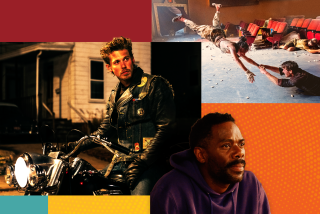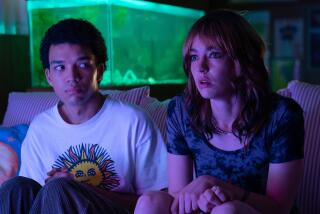Review: Guy Maddin’s ‘The Green Fog’ is an ingenious found-footage homage to ‘Vertigo’
- Share via
I have a friend who, in a rush to return a DVD of “Vertigo” she had borrowed, watched it distractedly on her laptop, fast-forwarding through most of the driving scenes. (In other words, a lot of the movie.) She made amends for this aesthetic crime years later by seeing Alfred Hitchcock’s 1958 masterpiece on the big screen, in a gloriously restored 70-millimeter print that allowed no escape from its dizzyingly perverse tale of romantic obsession or its slow, dreamlike crawl through San Francisco’s streets.
There is a lot of driving — and, in a funny way, a lot of fast-forwarding — in “The Green Fog,” a cracked, collage-like retelling of “Vertigo” from the brilliant Canadian director Guy Maddin and his regular collaborators Evan Johnson and Galen Johnson. And while this 63-minute gem is not something to watch while distracted, its stream of images, edited together from films and TV shows shot in and around San Francisco, cultivates its own kind of cinematic restlessness.
Commissioned by the San Francisco Film Society (SFFILM), this found-footage city symphony doesn’t have the hypnotic pull of “Vertigo” (what does?). Its cleverly repurposed visuals, pulled from works as different as “The Lady From Shanghai” (1947), “The Conversation” (1974), “Star Trek IV: The Voyage Home” (1986) and “Basic Instinct” (1992), benefit from but don’t necessarily require the grandeur of the big screen. Still, any chance to experience one of Maddin’s witty valentines to the treasures of cinema past should not be refused lightly. (Acropolis Cinema is showing the movie Tuesday and Wednesday night at the Downtown Independent; after that, it opens Friday for a week-long run at Arena Cinelounge Sunset.)
Fans of Hitchcock’s movie, which in 2012 was named the best film of all time in Sight & Sound’s decennial critics’ poll, will have no trouble following the narrative thread even in the absence of James Stewart and Kim Novak. The roles of Scotty Ferguson and Madeleine Elster are assumed by any number of acting duos, including Louis Jourdan and Doris Day in “Julie” (1956), Jeff Bridges and Glenn Close in “Jagged Edge” (1985), and Andy Garcia and Meg Ryan in “When a Man Loves a Woman” (1994).
The effect is a bit like watching “Vertigo” recomposed with ransom-note letters, set to a score (composed by Jacob Garchik and performed by the Kronos Quartet) that builds to its own Bernard Herrmann-esque swells of anxiety. If Hitchcock’s movie was a romantic tragedy about the impossibility of reconstructing the object of one’s desire, then “The Green Fog” is, fittingly, an imperfect double of sorts.
The eponymous green vapor that occasionally creeps into the frame is a sly bit of visual trickery that both evokes one of “Vertigo’s” most memorably creepy scenes and literalizes this experiment’s hazy, miasma-like effect. Nearly all the clips have been stripped of dialogue, preserving the continuity of Hitchcock’s narrative but also turning each conversation into an amusing exercise in disjunctive editing. And the plot, with its elaborate weave of suspicion and misdirection, has been distilled into a series of associative montages.
Part of the pleasure of “The Green Fog” comes from seeing how many Bay Area-produced films have featured actors racing over rooftops (like Sidney Poitier in 1970’s “They Call Me Mr. Tibbs!”), gazing at paintings (like Joan Leslie in 1950’s “Born to Be Bad”) and falling in mid-air (like Joan Crawford in 1952’s “Sudden Fear”). And then of course there are those shots of automobiles weaving up and down the city’s sharply inclined streets, a natural place to excerpt the mother of all car chases in “Bullitt” (1968).
All this amounts to more than just a bravura feat of archival manipulation or a “spot the Golden Gate Bridge” drinking game. It is, in effect, a scrambled history of San Francisco told through moving pictures, a record of the social and architectural changes the city has endured over more than a century. (The manner in which Maddin interpolates black-and-white footage from the devastating 1906 earthquake is especially arresting.)
“The Green Fog” may not be as personal or inventive in its urban mythmaking as Maddin’s 2007 fantasia, “My Winnipeg”; nor is it as feverish an imagistic brainstorm as 2014’s “The Forbidden Room.” But no less than those earlier pictures, it is the work of a sensibility as impish as it is scholarly, animated by a mischievous sense of the medium’s possibilities. Designations between high and low culture are stealthily eradicated: What to make of a project of this nature that doesn’t include “Zodiac” (2007), perhaps the greatest of recent Bay Area masterworks, but finds room for N’Sync’s “This I Promise You” video and both “Sister Act” movies? (As a “Sister Act” fan, I’m not complaining, just curious.)
Maddin returns often to two 1970s TV crime series: the Karl Malden-Michael Douglas detective drama “The Streets of San Francisco” and the Rock Hudson-Susan Saint James police procedural “McMillan & Wife.” The latter features a number of scenes in which Hudson and his colleagues watch surveillance footage, a framing device that allows Maddin to channel-surf between clips. But it also returns us to the themes of “Vertigo” itself, the greatest movie ever made about the intensely possessive relationship between the observer and the observed.
------------
‘The Green Fog’
Not rated
Running time: 1 hour, 3 minutes
Playing: Downtown Independent (Tuesday, Wednesday), Arena Cinelounge Sunset (starts Friday)
Movie Trailers
[email protected] | Twitter: @JustinCChang
More to Read
Only good movies
Get the Indie Focus newsletter, Mark Olsen's weekly guide to the world of cinema.
You may occasionally receive promotional content from the Los Angeles Times.











